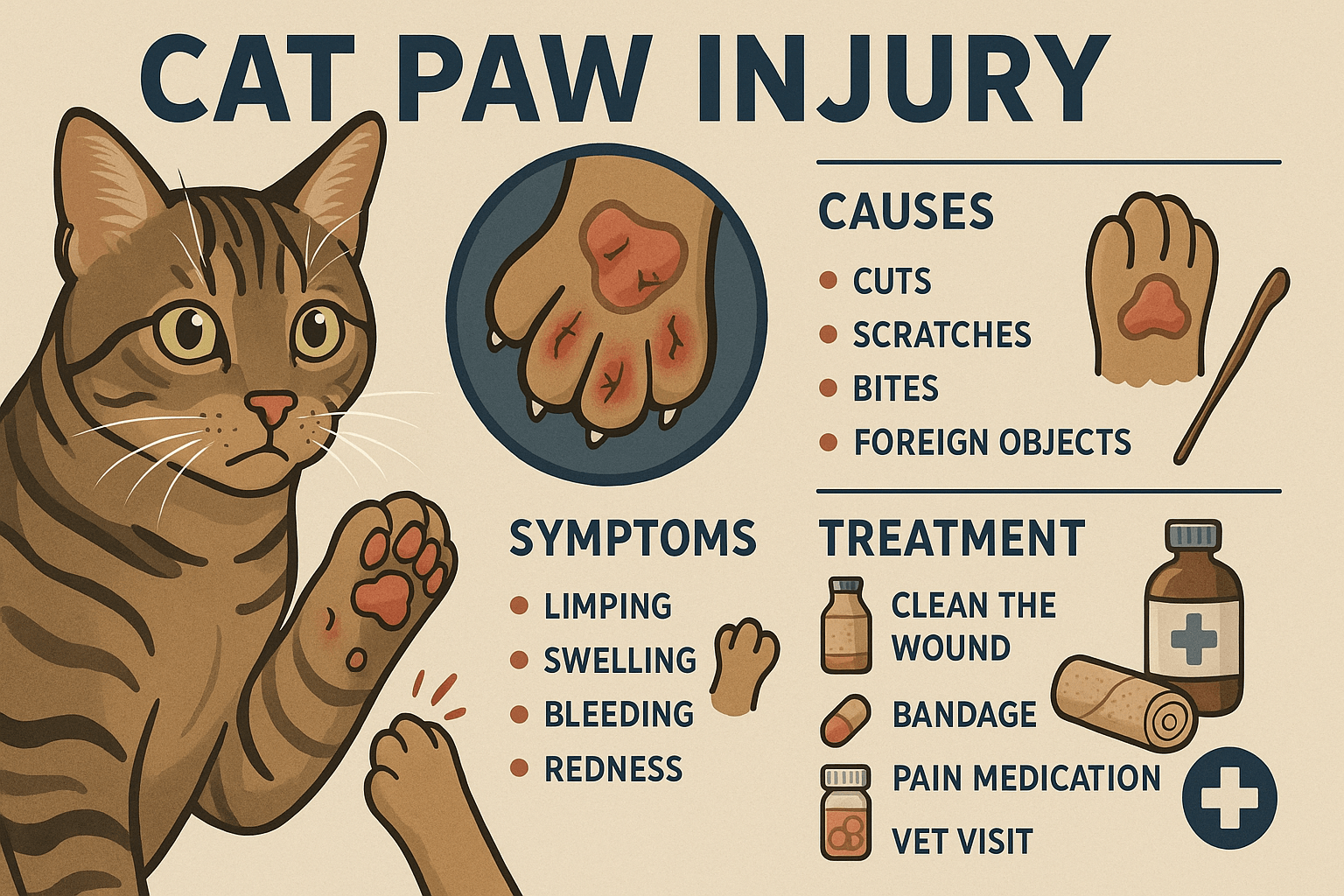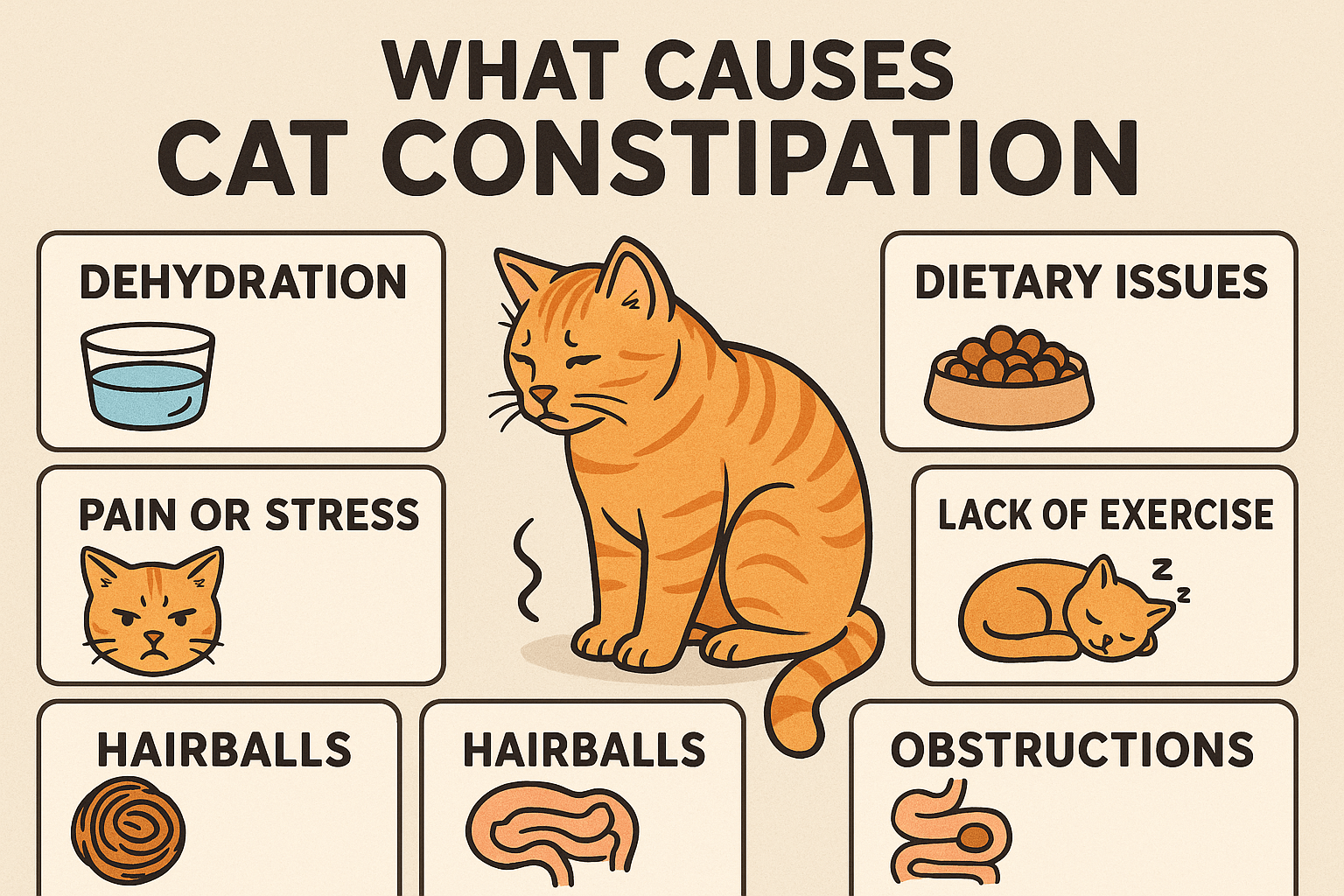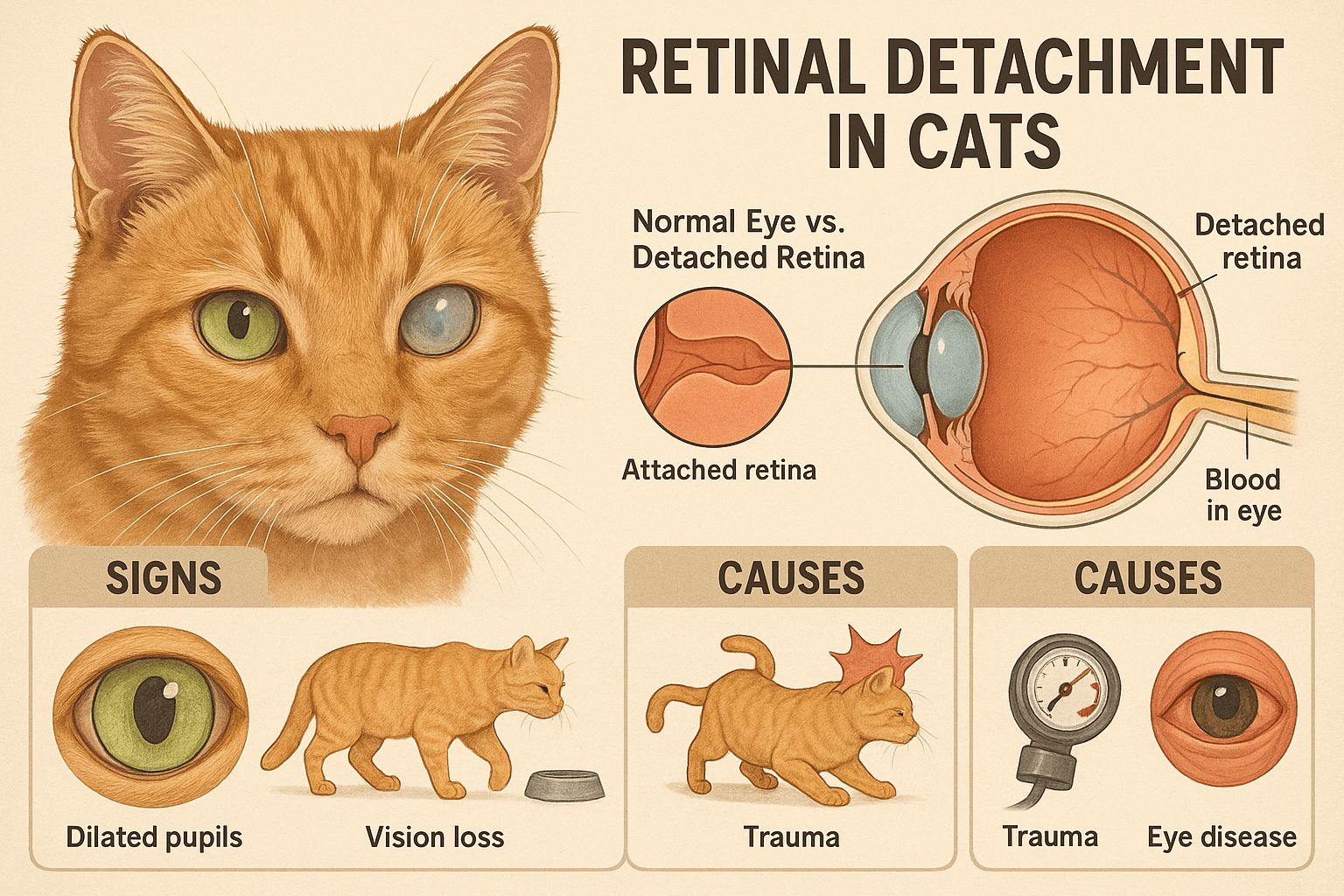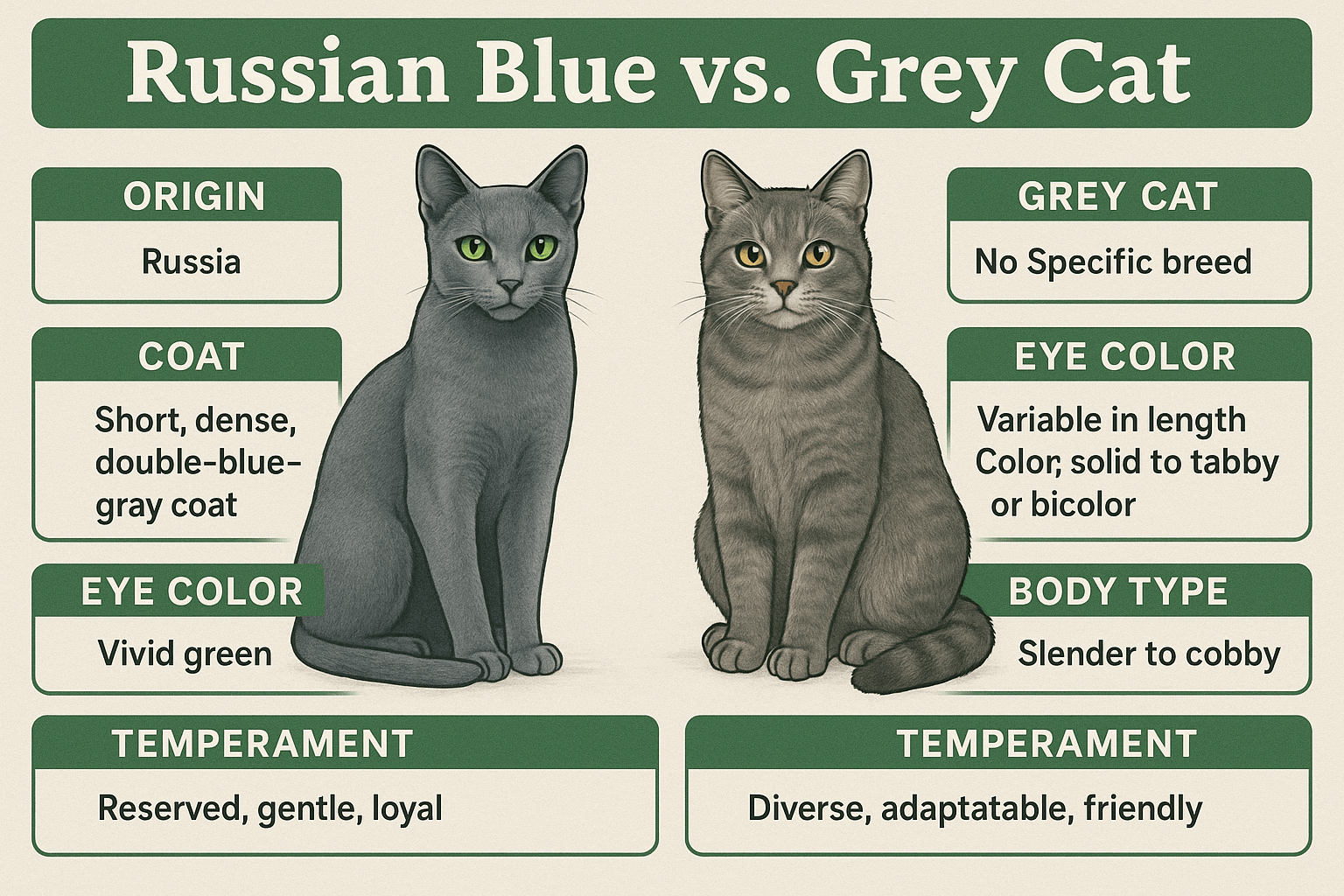Cat Paw Injury: What You Need to Know
Cats are naturally curious and agile creatures, but their adventurous nature can sometimes lead to injuries, particularly on their delicate paws. A cat paw injury may seem minor at first glance, but it can cause significant discomfort and even impact your feline friend’s mobility if left untreated. Whether caused by sharp objects, rough surfaces, or accidental trauma, understanding how to identify, treat, and prevent paw injuries is essential for every cat owner. In this guide, we’ll explore everything you need to know about cat paw injuries, from recognizing the signs to providing proper care and ensuring a speedy recovery.
Common Causes of Cat Paw Injuries
Cat paw injuries can occur in various ways, often depending on your pet’s environment and habits. Identifying the cause of the injury is the first step toward effective treatment and prevention.
Sharp Objects:
Cats may step on thorns, glass shards, or nails while exploring outdoors or even indoors. These objects can puncture the paw pad and cause pain.Burns from Hot Surfaces:
Walking on hot asphalt, radiators, or stovetops can lead to burns, especially during warmer months or in homes with heating elements.Frostbite in Cold Weather:
Prolonged exposure to freezing temperatures can damage the sensitive tissue of a cat’s paws, leading to frostbite.Bites or Scratches from Other Animals:
Fights with other animals can result in bites or scratches that affect the paws, introducing the risk of infection.Overgrown Nails:
Neglected nails can grow too long, curling into the paw pad and causing irritation or injury.
Understanding these common causes helps you take preventive measures and act quickly if an injury occurs.
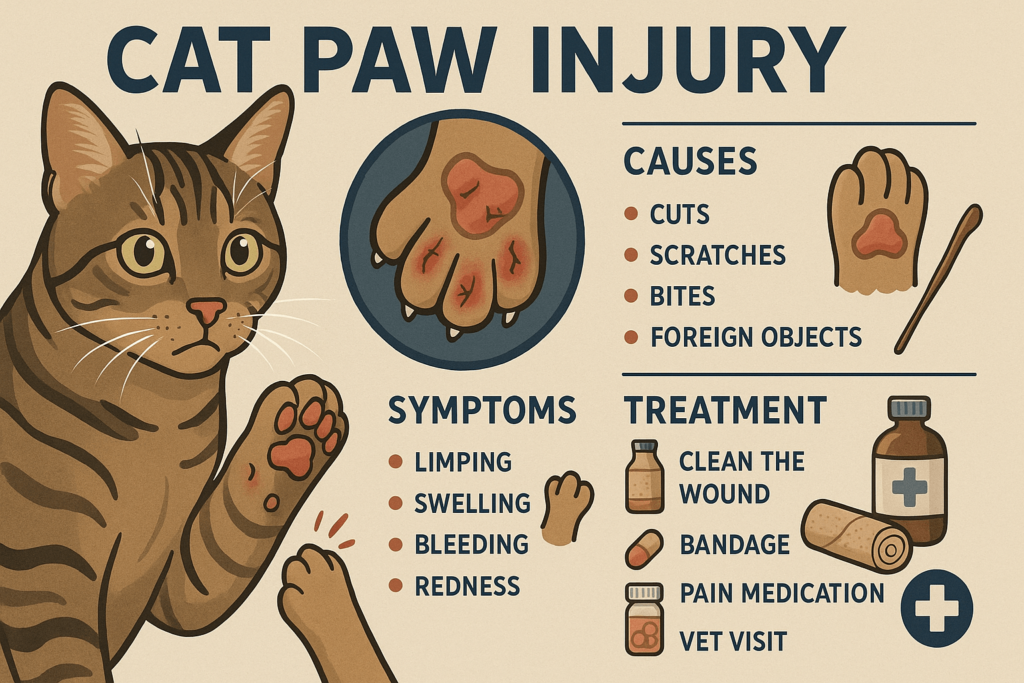
Signs Your Cat May Have a Paw Injury
Cats are masters at hiding pain, but there are telltale signs that indicate a possible paw injury. Keep an eye out for these symptoms to address the issue promptly.
Limping or Favoring One Paw:
If your cat avoids putting weight on a specific paw, it could be a sign of discomfort or injury.Excessive Licking or Chewing:
Cats often lick or chew at injured areas in an attempt to soothe themselves, which can worsen the condition.Swelling or Redness:
Inflamed or swollen paw pads are clear indicators of an underlying problem.Bleeding or Discharge:
Visible blood or pus suggests an open wound or infection that requires immediate attention.Reluctance to Walk or Jump:
A sudden change in activity levels, such as avoiding stairs or furniture, may point to a paw-related issue.
Recognizing these signs early ensures timely intervention and minimizes the risk of complications.
Check this guide 👉Ringworm on Cat Paw Pad: Best 7 Expert Tips!
Check this guide 👉Understanding Cat Paw Cancer: Best 7 Expert Tips!
Check this guide 👉Understanding Cat Paw Burns: Best 7 Health Tips!
Preventing Cat Paw Injuries | Treating Minor Paw Injuries at Home |
|---|---|
Regularly inspect your cat’s paws | Clean the wound with saline solution |
Keep indoor floors free of sharp objects | Apply a pet-safe antiseptic ointment |
Trim nails regularly | Cover the paw with a soft bandage |
Supervise outdoor playtime | Monitor for signs of infection |
Provide safe scratching surfaces | Limit movement until healing begins |
How to Treat a Cat Paw Injury Safely
If your cat sustains a paw injury, knowing how to provide first aid can make a big difference in their recovery. Follow these steps to ensure proper care.
Assess the Injury:
Examine the paw carefully to determine the severity of the injury. Look for foreign objects, cuts, or swelling.Clean the Wound:
Use lukewarm water or a saline solution to gently clean the affected area. Avoid harsh chemicals that could irritate the skin.Remove Foreign Objects Carefully:
If you notice a splinter or thorn, use sterilized tweezers to remove it. Be cautious to avoid causing further harm.Apply a Pet-Safe Ointment:
After cleaning, apply an antiseptic cream specifically designed for pets to prevent infection.Bandage the Paw (if necessary):
For deeper wounds, cover the paw with a lightweight, breathable bandage. Ensure it’s snug but not too tight to restrict circulation.
Proper treatment minimizes discomfort and promotes faster healing, allowing your cat to return to their playful self.
When to Seek Veterinary Care for a Cat Paw Injury
While minor injuries can often be treated at home, some situations require professional veterinary attention. Knowing when to consult a vet ensures your cat receives the care they need.
Deep Cuts or Punctures:
Wounds that penetrate deeply into the paw pad may require stitches or antibiotics to prevent infection.Persistent Bleeding:
If the bleeding doesn’t stop after applying pressure for several minutes, seek immediate medical help.Signs of Infection:
Symptoms like pus, foul odor, or increased redness indicate an infection that needs professional treatment.Foreign Object Embedded in the Paw:
If you’re unable to safely remove an object lodged in the paw, let a vet handle it to avoid complications.Lameness That Persists:
If your cat remains unable to walk normally after initial treatment, a vet visit is essential to rule out fractures or other issues.
Prompt veterinary care can prevent minor injuries from escalating into more serious health concerns.
Preventive Measures to Protect Your Cat’s Paws
Taking proactive steps can significantly reduce the risk of paw injuries for your cat. Prevention is always better than cure, and these tips will help safeguard your pet’s delicate paws.
Inspect Outdoor Spaces Regularly:
Check your yard or garden for sharp objects, thorns, or hazardous materials before letting your cat outside.Provide Soft Bedding Indoors:
Comfortable resting areas minimize strain on your cat’s paws and reduce the likelihood of abrasions.Avoid Extreme Temperatures:
Keep your cat indoors during extreme heat or cold to protect their paws from burns or frostbite.Encourage Safe Play:
Use toys and activities that don’t involve rough surfaces or sharp edges to keep your cat entertained safely.Schedule Routine Nail Trims:
Regular nail maintenance prevents overgrowth and reduces the risk of nails becoming ingrown or breaking.
By implementing these preventive measures, you can create a safer environment for your cat and reduce the chances of paw injuries.
Understanding Behavioral Changes Due to Paw Injuries
When a cat experiences a paw injury, their behavior often changes as they cope with pain or discomfort. Recognizing these shifts can help you identify hidden issues.
Decreased Activity Levels:
An injured cat may spend more time sleeping or lying down to avoid aggravating their paw.Aggression or Irritability:
Pain can make cats more defensive, leading to growling, hissing, or biting when touched.Changes in Eating Habits:
Stress or discomfort from an injury may cause a temporary loss of appetite.Hiding More Frequently:
Cats instinctively hide when they’re unwell, making it harder to detect injuries.Unusual Vocalizations:
Whining or meowing excessively can signal distress related to a paw injury.
Paying attention to these behavioral cues allows you to intervene early and provide the care your cat needs.
Long-Term Care for Chronic Paw Issues
Some cats may experience recurring or chronic paw problems, requiring ongoing management and care. Here’s how to support your cat’s long-term paw health.
Regular Vet Check-Ups:
Schedule routine visits to monitor any persistent conditions and adjust treatments as needed.Maintain a Healthy Diet:
Proper nutrition supports tissue repair and boosts your cat’s immune system for faster healing.Use Protective Booties:
For cats prone to paw injuries, protective booties can shield their paws during walks or outdoor adventures.Keep Nails Short and Smooth:
Regular trimming prevents nails from snagging or causing additional trauma to the paw.Monitor for Recurrence:
Stay alert for signs of reinjury or worsening symptoms, and seek veterinary advice promptly.
With consistent care and attention, you can manage chronic paw issues and ensure your cat enjoys a high quality of life.
Frequently Asked Questions About Cat Paw Injuries
Can I use human first aid products on my cat’s paw?
No, many human products contain ingredients that are toxic to cats. Always use pet-safe alternatives.
How long does it take for a cat paw injury to heal?
Minor injuries typically heal within 7-10 days, but more severe cases may take weeks under veterinary supervision.
Should I keep my cat indoors while their paw heals?
Yes, limiting outdoor activity reduces the risk of reinjury and allows the paw to heal properly.
What if my cat won’t let me touch their paw?
If your cat resists handling, consider wrapping them in a towel to restrain them gently or seeking professional help.
Can I prevent my cat from licking their injured paw?
Use an Elizabethan collar (cone) to deter licking, which can delay healing and introduce bacteria to the wound.
Prioritizing Your Cat’s Paw Health
A cat paw injury might seem like a small issue, but it can significantly impact your pet’s comfort and mobility. By staying vigilant, acting quickly when problems arise, and taking preventive measures, you can protect your feline companion from unnecessary pain and suffering. Remember, your cat relies on their paws for nearly every activity, so keeping them healthy is vital for their overall well-being. With love, patience, and proper care, you can ensure your furry friend stays happy and active for years to come.
What Causes Cat Constipation? Best 7 Expert Tips! Discover common causes, symptoms, and solutions for cat constipation to keep your feline healthy and comfortable.
Cat Paw Injury: Best 7 Expert Tips! Discover essential advice on identifying, treating, and preventing cat paw injuries to keep your feline friend healthy and happy.
Retinal Detachment in Cats: Best 7 Expert Tips! Learn to identify symptoms, understand causes, and explore treatment options to protect your cat’s vision effectively.
Russian Blue vs Grey Cat: Best 7 Expert Tips! Discover key differences, unique traits, and expert advice to help you choose between a Russian Blue and a generic grey cat for your perfect feline companion.

